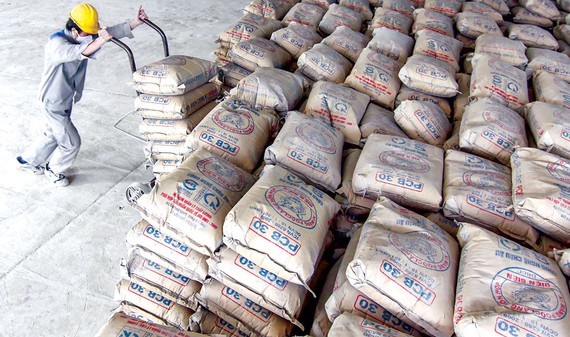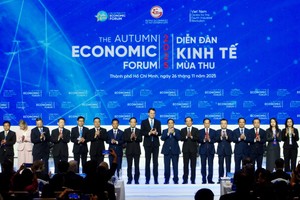 Illustrative photo
Illustrative photo
Low profits
According to data announced recently from the Import and Export Department of the Ministry of Industry and Trade, in the first half of 2021, the cement industry exported nearly 21 million tons of cement and clinker products, valued at US$812 mn. This volume was equivalent to export volume of the whole year of 2017. The amount has also increased by 27% from 2017, and by 32% from 2020. Before that, during three consecutive years between 2018 until 2020, the cement industry exported large quantities at high price of more than $1 bn per year. In 2020 alone the industry exported around 38 million tons, worth $1.46 bn.
One representative of the Vietnam Cement Association (VNCA), explained that although the cement industry has been affected by the Covid-19 pandemic, exports have still increased, because Vietnam's cement has created a mark in the world market. The cement industry is in a huge position to oversupply, and exports are the main channel to help the industry offload stocks. Statistics show that the structure of Vietnam's cement and clinker consumption between domestic and export markets has changed significantly in recent years, while the proportion of consumption in the domestic market has decreased by only 38%, exports have increased by 62%. It is forecast that exports in the cement industry will remain the main trend in coming years.
Currently, Vietnam's cement industry has 90 clinker and cement production lines with a total capacity of 107 million tons per year, with 80% clinker and 20% additives. The actual capacity is about 120 million to 130 million tons of cement, with 70% clinker and 30% additives. At this scale and capacity, the cement industry is being considered to have a dominant role on markets in the region. In the world market, Vietnam is ranked 5th in terms of cement production capacity, after China, India, USA and Russia. However, the existing paradox is that despite the rapid growth rate, and even exports being always high, the profit margin for the cement industry may be reduced due to increase in supply capacity and fuel costs.
Cement businesses are often directly affected by coal and electricity prices. Specifically, this industry faces a huge risk because of the cost of coal and electricity which accounts for 40% to 45% of the cost of clinker production. In particular, the price of clinker accounts for more than 60% of the cost of input materials for cement, making the profit of the whole industry fluctuate greatly according to the price of electricity and coal. Currently, the export channel is favorable to consume significant output of the cement industry, especially with the price of clinker increasing since the beginning of the year. However, as long as the price of coal and electricity increases even slightly, export efficiency will not be high.
Besides, in the short term, a lot of production can cover domestic capacity, but in the long run, this is not a sustainable solution. Cement is a non-renewable resource extraction industry, exporting a lot will deplete resources, especially in a situation of price pressure, making profit margin not large enough.
Risks in markets
According to a recent report by SSI Securities Company, one of the biggest risks facing Vietnam's cement industry is the volatility of the export markets. The reason cement exports increased sharply was due to China's change in investment policy for this industry. Specifically, China has limited and is gradually reducing cement factories, mainly for environmental purposes, which has increased clinker imports from abroad, especially from Vietnam. During the period 2017 until 2019, China became the largest importer of cement and clinker from Vietnam. Currently, the Chinese market accounts for 57% of cement and clinker exports, accounting for 22% of Vietnam's total consumption in 2020.
Excessive dependence on the Chinese market is also a huge concern, especially as fiscal policy in this country may be tightened in coming years. The export volume of cement products in the first six months of 2021 exceeded the target, because China's demand was still high due to this market's continued strong investment in infrastructure. However, in coming time, it will be difficult for exports to this market to achieve strong growth, when domestic supply in China gradually stabilizes. Therefore, cement exporters need to be aware that if China stops its infrastructure stimulus policies, export output will decrease by about 25% to 30% in the short and medium term.
After China, the second largest market for Vietnam's cement exports is the Philippines. However, now this country is accusing Vietnam of dumping cement products, which has affected the domestic cement production. The third largest market of Vietnam's cement exports is Bangladesh, accounting for 12.5% of the total volume, and for 11.2% of the total export turnover of cement and clinker. Other import markets for Vietnam are Peru, Malaysia, Taiwan, Australia, Indonesia, and Laos, but their proportion of market share is not much.
According to some economic experts, it is time for the cement industry to rethink about restructuring, which must take into account factors such as input costs with the export price of cement, and consider the value of exports, including resource exploitation as well as costs to protect the environment. In addition, the effectiveness of cement exports needs to take into account the principles of the market, such as the input of raw materials for the industry, as we cannot continue to subsidize prices any more. As the price of electricity and petrol is operated according to market principles, it is forcing businesses to calculate correctly, thereby directing production and improving technology, as well as changing management skills in business activities.
Market activities and exports must ensure costs and improve efficiency in consumption and export of cement. This must be assessed more carefully among ministries, sectors and management agencies, if long-term orientation is desired. It is now necessary to take into account better planning to ensure sustainable development in the future.
























